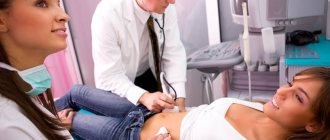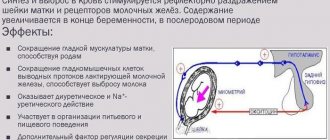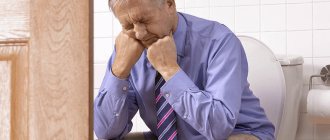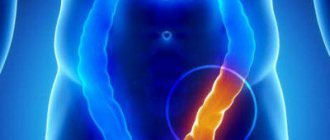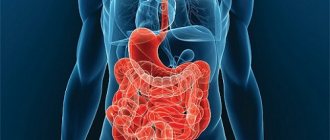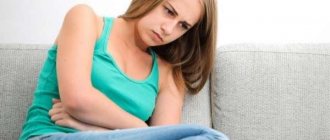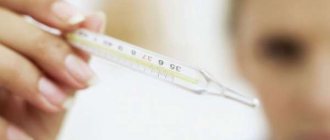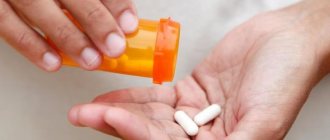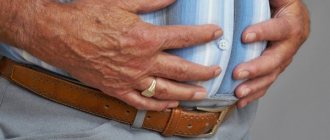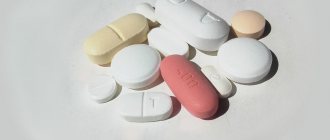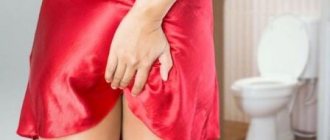Factors that provoke the occurrence of this problem
Varicose veins in the rectum are formed under the influence of certain risk factors. Among them, the most common are:
- adynamia;
- lifting weights;
- hereditary predisposition;
- harmful taste preferences (spicy, salty, fatty foods);
- excessive consumption of alcohol, tobacco;
- constipation;
- pregnancy and childbirth;
- binge eating;
- pathology of the genital organs;
- local irritation in the form of anal penetrations, including frequent enemas, increased constant care of the anus.
If there is colitis, the altered intestinal mucosa compresses numerous nerve receptors and veins. Inflammation spreads to surrounding tissues and hemorrhoids. They increase significantly and begin to crawl into the intestinal lumen.
The mechanism of its development is explained by the abundant innervation of the anus. Thanks to a large number of receptors, the pain impulse is transmitted to neighboring organs. The formation of abdominal pain occurs in several stages:
- The nodes significantly narrow the intestinal lumen, their surface is damaged by hard feces. In case of injury, bleeding from the damaged node may occur. The small clots that form pinch the nerve endings, which causes pain.
- Pain radiates to healthy organs thanks to numerous nerve receptors - its localization in the abdomen is different.
- Due to the significant thickening of the intestinal wall at the location of the venous cones, the intestine, with constipation or severe flatulence, is in close contact with nearby organs. This explains pain in women during sexual intercourse and in men during urination.
There are many other reasons that cause abdominal pain with existing hemorrhoids in women. The most common include:
- Neurogenic (psychological) - due to increased emotionality, stress is more difficult to bear. This affects all organs, including the intestines.
- Restricted diets cause intestinal dysfunction.
- Pathology of the female genital area - stagnation develops in the pelvis, especially in the presence of chronic, sluggish diseases.
- Pregnancy and childbirth increase congestion: the growing uterus compresses the blood vessels, increasing intra-abdominal pressure and increasing blood flow to the veins.
- Menstruation - on critical days, blood flow to the pelvic vessels increases, causing an exacerbation of hemorrhoids.
- Adynamia is the result of professional activity. Many women's professions are associated with sedentary work. Daily low physical activity causes venous congestion in the pelvic vascular system.
- Neoplasms - irritate or destroy the intestinal walls, impair blood circulation, which can result in the development of hemorrhoids.
- Damage to the intestinal mucosa - during inflammation, the epithelial layer becomes thinner and easily damaged. Cracks form that do not epithelialize for a long time due to constant mechanical irritation. Lack of treatment causes the process to become chronic, which is manifested by constant pain.
In men, abdominal pain occurs with the development of inflammatory processes in the genitourinary organs, which are the result of infection or other causes. Most often, symptoms are associated with the following diseases:
- orchitis;
- prostatitis;
- cystitis;
- prostate or bladder tumors.
Treatment methods
If initial signs of hemorrhoids appear, you should consult a doctor who, in accordance with the stage of the disease, will prescribe adequate treatment. Typically, therapy is carried out with the following groups of drugs:
- non-narcotic painkillers;
- anti-inflammatory drugs;
- venotonic drugs;
- medications that dissolve blood clots;
- wound healing suppositories.
Prevention of hemorrhoids is daily walking in the fresh air, which normalizes blood circulation in the pelvic organs and intestinal functioning.
Simultaneously with drug therapy, physiotherapy is prescribed in the form of mud therapy, electrophoresis, magnet, the action of which is aimed at enhancing the therapeutic effect of drugs, strengthening veins, and relieving inflammation. The patient is recommended to have a gentle diet with increased intake of fluids, fermented milk products, fresh vegetables and fruits. It is necessary to exclude spicy, fatty, salty, sweet foods, and alcohol. It is recommended to establish vigorous activity and not lift weights.
Abdominal pain can be a sign of hemorrhoids and a reason to visit a proctologist. Timely treatment will help cure the disease and prevent the development of complications.
Where else can hemorrhoids cause pain?
Depending on the location, the symptoms of the disease differ. According to the clinical course, external and internal hemorrhoids are distinguished.
The mucous membrane of the external nodes is covered with pain receptors. The pain is localized in the anus.
With internal hemorrhoids, the nodes are located inside the anal canal. The sensitivity of the formations is low, since there are practically no pain receptors on the surface of the mucous membrane. A distinctive feature of the disease at the initial stage of development is a blurred clinical picture. In advanced conditions, hemorrhoids are accompanied by severe pain in the lower abdomen, which is often a reason to seek emergency medical help.
Factors in the development of pain syndrome:
- Damage to convex formations by feces.
- Transfer of unpleasant sensations along nerve endings to healthy organs (innervation).
- Contact of the inflamed area with neighboring organs. You may experience pain during sexual intercourse and urination.
According to the clinical course, external and internal hemorrhoids are distinguished.
Also, in some patients, pain from the anus may radiate to the back, tailbone, or lower abdomen. Why is that?
Backache
In patients with hemorrhoids, the back hurts for two reasons, namely:
- during an exacerbation of hemorrhoidal disease, patients try to alleviate their condition in all sorts of ways, including taking a forced position of the body, and such positions are not always physiological and comfortable. Pain in the anus may be relieved, but excessive tension in the back muscles occurs, which will provoke pain in it;
- irradiation of back pain along the nerve roots.
Pain in the back caused by hemorrhoids typically appears only when the process worsens or its complications develop. But in any case, you need to consult a specialist who will help alleviate the condition and rule out other causes.
Pain in the tailbone
Pain in the tailbone with hemorrhoidal disease is very rare, so first of all you need to exclude other causes of pain.
But still, if the connection between pain in the coccyx and hemorrhoids is proven, then this symptom most often occurs not because of the hemorrhoidal lumps themselves, but because of the constipation that they provoke, inflammation of the perirectal tissues or rectal fistulas.
Lower abdominal pain
The main cause of pain in the lower abdomen with hemorrhoidal disease is the irradiation of pain from the rectum, which arises from damage to the nodes by hardened feces. Moreover, such a spread of pain is observed only with internal hemorrhoids.
Also, pain in the lower abdomen can be due to constipation, since with this disorder of the intestines, its walls are overly stretched by feces, which causes pain.
Painkillers
High-quality painkillers
To relieve symptoms, whether the stomach hurts due to hemorrhoids or a burning sensation in the anus, you need to use painkillers. Let's look at the most well-known drugs.
These include no-spa, diclofenac, ibuprofen. They help relieve pain and reduce swelling of inflamed nodes.
They are easy to use, quickly relieve pain and have virtually no side effects.
Relief
These candles are the most common. Their advantage is that they can be used by pregnant and lactating women. The pain subsides after 2-3 applications.
Anesthesiol
The main purpose of these suppositories is to relieve pain and relieve inflammation. In addition, they are effective for healing microcracks. They help to perform the act of defecation gently and painlessly.
Neo-Anuzol
Ideal for healing and drying wounds, providing an anti-inflammatory effect. Eases pain.
Recommended for young women who do not have hypertension. Suppositories relieve pain and stop bleeding as quickly as possible.
Such suppositories eliminate discomfort and help reduce pain. Let's look at the most popular of them.
Posterisan
In addition to pain relief, suppositories relieve inflammation and heal cracks. Increases the overall immunity of the body.
This universal drug not only relieves pain, but also reduces swelling, improves vascular elasticity and promotes good blood circulation.
A hormonal drug that relieves inflammation and reduces pain.
Abdominal pain due to hemorrhoids - why?
With further progression of hemorrhoids, the pain in the right side, left or lower abdomen intensifies. Sometimes this is the only clinical manifestation of varicose veins. Other signs (bleeding, burning, itching) are absent for a long time. The main causes of pain:
- Narrowing of the intestinal lumen due to protruding venous nodes.
- Digestive dysfunction. The nature of the stool changes: constipation is associated not only with a gradual decrease in the internal diameter of the intestine, but also with digestion processes. With large nodes, a sharp narrowing makes it difficult to move stool; pain mainly manifests itself in the lower abdomen on the left side - in the area of the sigmoid colon, which turns into the rectum. During the inflammatory process, it also appears on the right side of the abdomen. If you hesitate and do not treat the emerging pathology in a timely manner, the pain will continue to bother you even in the phase of stable remission. Intestinal dysfunction causes flatulence, which is accompanied by constant heaviness and distension in the abdomen. The accumulation of gases puts pressure on the walls, causing them to stretch and cause aching pain in the lower abdomen.
- Anal fissures are an entry point for infection. The mucous membrane of the rectal intestine is damaged by feces. Bacteria penetrate through the resulting defects.
- Acute pathology - peritonitis, intestinal obstruction due to hemorrhoids. Impaired patency manifests itself as constipation, which increases pain.
How to get rid of lower back pain due to hemorrhoids?
Since the main cause of lumbar pain in patients with hemorrhoids is the presence of hemorrhoids or the development of complications, you can only get rid of this unpleasant symptom by curing hemorrhoidal disease.
Treatment of hemorrhoids consists of the following principles:
- diet;
- increased physical activity;
- taking drugs that have venotonic and angioprotective effects (Venarus, Detralex, Phlebodia 600, Troxevasin, Aescusan and others);
- the use of local medications that help eliminate the unpleasant symptoms of hemorrhoids, including pain. For internal hemorrhoids, rectal suppositories are mainly used, among which the most effective are Proctosedyl M, Relief Advance, Ultraproct, Procto-Glivenol, Proctosan, Olestesin and others;
- the use of folk remedies (baths, microenemas, homemade suppositories and ointments), which complement traditional treatment.
You can also alleviate the condition with the help of painkillers, such as Spazmolgon, Nurofen, Xefocam, Nimesil and others. In cases of severe pain, novocaine blockades can be performed.
Conservative therapy is effective in the initial stages of hemorrhoids, but when the disease has reached stages 3-4, then surgical treatment has to be resorted to.
Diagnostics
As mentioned above, abdominal pain is not a disease, but a symptom. To diagnose the cause of symptoms, the doctor must take a medical history. After interviewing the patient, he proceeds with the physical examination. First, the abdomen will be palpated. The doctor will also listen to the patient with a stethoscope (auscultation).
Using ultrasound, blood tests, and colonoscopy, you can obtain additional information about the patient’s health status. Different symptoms require different types of therapy. A slow increase in the intensity of pain is observed in inflammatory diseases of various origins.
What other pathologies are accompanied by pain in the lower abdomen?
Many causes of pain in the lower abdomen are the same in both women and men:
- diseases of the urogenital system;
- helminthiases.
In women they are caused by common gynecological diseases:
- endometritis (inflammation of the uterus);
- ectopic pregnancy;
- erosive changes in the uterine cervix;
- cystic lesion of the ovaries.
Abdominal pain is caused by intestinal pathology, which often accompanies hemorrhoids:
- Crohn's disease;
- dysbacteriosis;
- irritable bowel syndrome (IBS);
- cancer of the intestine or other organs with metastases;
- proctitis
Pathologies of other digestive organs (stomach, liver) during the period of severe exacerbation cause disruption of all processes of food digestion. The functions of the listed organs and the colon are impaired. Therefore, any disruption of the stomach or liver functions provokes pain in the lower abdomen on the right.
Causes of pain
The development of the disease is influenced by many factors. Among them: hereditary predisposition (weakness of muscle tissue), congenital malformations (lack of venous valves), excess weight, bad habits, heavy physical activity, long-term bowel disorders (diarrhea, constipation).
Despite the fact that lumbar pain in patients with hemorrhoids is not uncommon, the causes of this symptom are still such concomitant diseases as:
- diseases of the spinal column (osteochondrosis, scoliosis, lordosis, intervertebral hernia, vertebral injuries);
- joint diseases (joint tuberculosis, hip arthrosis and arthritis);
- oncological diseases of the skeletal system, urinary and digestive systems;
- diseases of the digestive system (intestinal obstruction, colitis, pancreatitis, cholelithiasis, appendicitis);
- pathology of the urinary system (urolithiasis, cystitis, pyelonephritis) and others.
The following features will help to distinguish hemorrhoidal pain in the lumbar region of the body from the above diseases:
- pain is always associated with exacerbation of hemorrhoids;
- pain occurs or increases during bowel movements;
- pain increases when sitting, especially on hard surfaces;
- the pain has an aching, pulling nature, but during the development of complications it can become throbbing, pressing or spastic.
In this condition, the pain becomes sharp and severe during any movement and requires medical attention.
To determine the exact cause of lumbar pain, a comprehensive examination of the body is carried out, first of all, radiography of the lumbar spine. In addition, you may need an ultrasound examination of the abdominal organs, fibrocolonoscopy, computed tomography and magnetic resonance imaging, as well as many others.
If you suffer from hemorrhoids and have lumbar pain, then under no circumstances engage in self-diagnosis, much less self-medication, but immediately consult a proctologist. Only a proctologist, after carrying out a set of diagnostic methods, will determine whether your lower back pain may be caused by hemorrhoids or whether it is due to other reasons.
